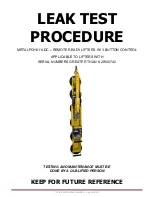
TST-019 MRTALPCH CHANNEL
– Rev. 2016-310
Page 7 of 20
Once the vacuum generating system is confirmed to not leak, reattach the pad lines to the
filters and repeat the original vacuum test with all parts attached and the power in the off
( )
position.
If the vacuum level, as shown
on the lifter’s vacuum gauge(s), starts and continues to drop,
this indicates that there is still a leak present in the pad system. Proceed to the Pad System
Tests.
If the
vacuum level as shown on both of the lifter’s vacuum gauges holds steady and does
not drop, the indication is that there are no leaks in the vacuum system between the check
valves and the vacuum pads. Proceed to next step.
9) Repeat the vacuum test with all parts attached and the power switch left in the on
( )
position.
If the vacuum level,
as shown on both of the lifter’s vacuum gauges, holds steady and does
not drop and the lifter does not cycle during the second test with the power switch on,
proceed to System Confirmation.
If, during the second test with the power switch on
( )
, the lifter cycles, but there is no
indication of a leak,
as shown on the lifter’s vacuum gauges, the indication is a special
circumstance unique to this lifter design. Proceed as follows.
10) The following deals with a specific issue, where, if during a vacuum test of the whole lifter, the
vacuum pump cycles regularly
but the system’s vacuum level does not drop (no leak indicated
by either vacuum gauge), the indication is that a leak exists between the vacuum pump and the
check valve(s).
If either the solenoid valve that seals off the vacuum pump to the vacuum system, the vacuum
switch, or the connections from the pump to the vacuum switch or vacuum tank(s) were to
develop a leak, but the check valves sealing the main vacuum circuits still seal properly, the
result is that the pump will recycle regularly even though the vacuum level on the vacuum
gauges does not indicate a leak. This is caused by the fact that the area the vacuum switch is
located in is sealed via the pump valve and, if a leak were to exist in this section, the vacuum
switch would sense the leak and cycle the system to maintain its set vacuum level. However,
since the vacuum gauges are located in the individual vacuum circuits, which are sealed via
their respective check valves, there would be no loss of vacuum shown on either vacuum
gauge if the check valves continue to keep the pad system sealed. If this is the situation,
proceed as follows.
11) The vacuum tanks are connected to the pump by
the 3/8" O.D. hose connected to the 45° barbed
fitting (
6A
), of the pump solenoid. Note, the valve
shown is for lifters with serial numbers before
20161736. If your lifter has serial number
20161736 or greater, there will be a digital
vacuum switch attached to the valve. The test is
the same for either configuration.
Note, to provide easier access to the connected
hose, the hose cover (shown in
FIGURE 13
) was
removed from the channel and hose
6A
pulled out
of the frame slot before performing the test shown
in
FIGURE 7
.
FIGURE 6
6A
Содержание MRTALPCH611LDC
Страница 2: ...TST 019 MRTALPCH CHANNEL Rev 2016 310...









































